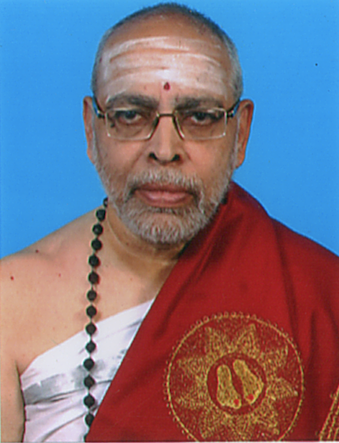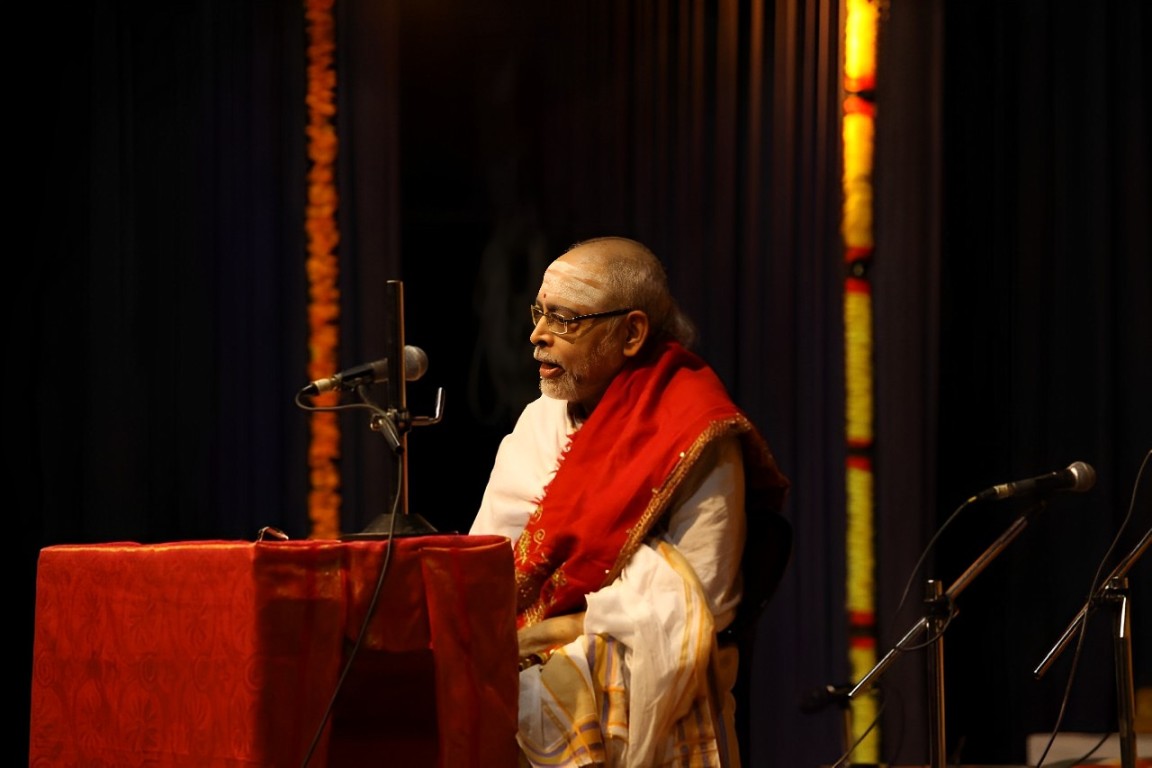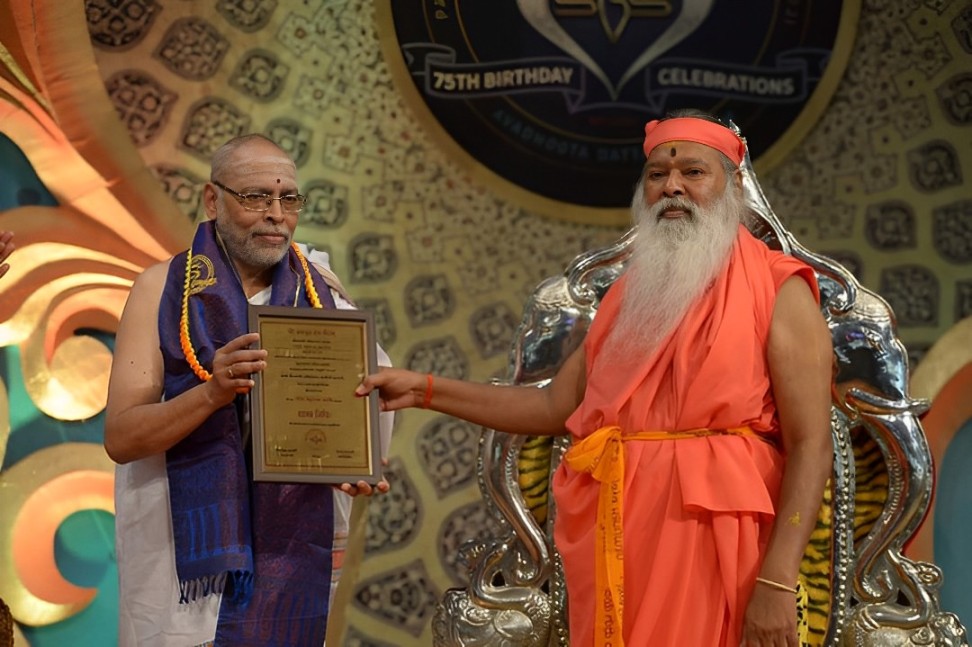
Sri Goda Venkateswara Sastrigal was the eldest son born to Smt.Goda Krishanaveny and Sri.Goda Narayaniah Dampati belonging to the Bharadwaja Gotra of Veginadu Telugu Brahmin Family on Sarvajit Samvatsara Pushya Masa Purvabhadra Nakshatra; 16th January 1948 in Nemilicherry near Chennai. After his Upanayanam, he had undergone adhyayanam of swashaakaa (RgVeda) under his own father. He obtained Gold Medal in M.Sc (Mathematics) and served as an officer in RBI. He had formal training in Sastriya Carnataka Sangeeta in violin.
‘Atmavidya Bhushanam’, ‘Vidyalankara’, ‘VidyaVaridhi’ Injikollai Sri V.Jagadeeswara Sastrigal was the Srividya Guru of their Family. Since his young age, Sri Goda sastrigal studied Kavya, Nyaya, Vyakarana, Sankya, Yoga, Purva Mimamsa and Advaita Vedanta under the Lotus feet of Sri Injikollai Sastrigal. He also received Poorna dīkṣā from him. In 1975, Sri sastrigal had vivaha samskara with Smt.Suryakumari, the daughter of Sri Somesvara Rao and Smt. Shakuntala and were blessed with two male children. Sri Somesvara Rao was freedom fighter from Munganda village in East Godavari District.
Following the words तद्विद्धि प्रणिपातेन परिप्रश्नेन सेवया, Sri Sastrigal and his Patni rendered a great Service to their Guru who was suffering due to old age during the later stage of his life. The family resided adjacent to their Guru’s Home and helped in performing day to day activities and NityAnustanas including Sandyavandhanam. Sri sastrigal took Guru’s pancapatra and performed Argyapradhana on his behalf. When Sri Jagadeeswara Sastrigal’s eyesight weakened, Sri Sastrigal read the bhasya text while he was explaining the same at the Bharatiya Vidya Bhavan in Chennai. The punya dampati performed shisrusha in every possible manner. The bond between the Guru and Shisya is an everlasting one and as a testimony to the same on 14/3/1983 at 4:30 am Sri Jagadeeswara sastrigal uttered “Venkatesa!” (This is how he used to address Sri Goda sastrigal) and shed his mortal coils on the lap of his Priya shishya. In this manner Sri Sastrigal fulfilled his duty as a true student.
He received the title of Siromani in Sahitya, Mimamsa, Nyaya, and Vedanta Sastras. He submitted a critical edition of “Siddhanta Deepa” by Sri Viswaveda Guru of Madhusudhana Saraswati, foremost commentary on “Sankshepa Sariraka” authored by Sri Sarvajnaatman , and received the title of “Vidya Varidhi”. This book along with Srividya (Brahmavidya) Guruparampara Mahamandala Saprya Paddhatihi was published in 2023 during the 75th birthday celebrations.
Guru Parampara
He had undergone Adhyayana of Pada and Krama Patas from Sri Sankara Sastrigal. Sri Sastrigal was a Nisnatha in both Brahma Vidya and Sri Vidya. Injikollai Sastrigal studied Vedanta and Nyaya under Yajnyaswami Sastrigal, the grandson of Sri Mannargudi Periyavaal. Therefore, he belonged to the lineage of the illustrious Mannargudi Parampara. Since his Paramaguru was “SIR” Sri Chidanandanatha, the founder of the Guhananda Mandali, he belongs to the Guhananda Mandali in the Srividya Sampradaya.
Even though he had studied all the Sastras under Injikollai Sastrigal, he also studied for a short period of time under other Pandits. He studied Nyaya and Rig Veda Bhashya under Sri Goda Subrahmanya Sastrigal, Veda Bhashya under Sri Sivarama Krishna Sastrigal, Mimamsa under Sri Ramamurthy Sastrigal, and Learned Jyotisha from a Guru whose name is unknown.
Teachings
He conducted Bhaashya Paatas for about 35 years at the Sri Sankara Gurukulam which was established by sastraratnakara Sri Tethiyur Subrahmanya Saastrigal at Abhiramapuram, in accordance with the tradition by rendering Santhi Paatas. He completed teaching Prasthana Traya Bhashya Paatas twice. In 1980, he started teaching Sanksepa Sariraka on the Vijayadashami day at the Bharatiya Vidya Bhavan. Until his lifetime (2018), he conducted classes there on Upanishads, Prakarana Granthas viz, Viveka Chudamani, Upadesha Sahasri, Vedanta Panchadashi etc., Sankara stotras like Ganesa Pancaratnam, Subrahmanya Bhujangam, Dakshinamurthy Stotram, Shivananda Lahari, Hari Meede stotram etc., Vishnu Sahasranama Bashya, Saundaryalahari with various Bhashyas including Lakshmidhara, GopalaSundari etc. in great detail. He taught Lalitha Sahasra Nama with Saubhaagya Baskara Vyakhyana. Visual presentations were specially used to explain Sri Chakra Avaranaas, Dasa Maha Vidyas and Muthuswami Dikshitars’ Navavarana Krithis. He also explained the chalarnava sutras in the Bhashya by providing hand-written notes having a collection of Naamaas compiled from each Kala. Kala Puja was performed after completion of each kala from the bhasya.


Since 1-2-1982 he started taking classes at the Gnanabhaskarasangham founded by Jyesta Srividyopasaka Smt.Raja Mami on Lalita Sahasranama bhasya, ParasuramaKalpa sutra, Varivasya Rahasya, ShaktiMahimna Stotra, Durga Saptasati along with Guptavati, Purascharanareetyaa Lalita trisati bhaasya , Saankara prakarana granthas for over 25 years. Once at the completion of Sahasranama Bhasya, here, Sri sastrigal explained all 1000 naamas from behind a curtain continuously for over six hours. This reminds an anecdote from the life history of Sri Bhaskararaya expounding the charitras of the yoginis at kashi.
At the residence of a student, he took class on Ramayana explaining every verse along with the Amrtakataka vyakhyana. In a similar manner, he explained every verse of Srimad Bhagavatam completely.
He took rare texts like Bhagavadgita with Venkatanatheeya commentary, Adhyatmapatala from Apastamba Dharmasutra with sankara bhasya, Garbopanishad and less known minor texts. Together with Mullaivasal Vasal Sri Krishnamurthy Sastrigal and Sri Mani Dravida Sastrigal, he completed Advaita Siddhi and began Svarajya Siddhi. Most of the times all the three pandits travelled and took part in Sadas together and most of the Vedanta classes in Mylapore were handled by them. Hence, they were looked upon as the “Vedanta Trimurthis.
At his residence, he taught various texts on wide range of subjects, viz.,The Prasthana Traya Bhasyam with references to tika, Bhamathi, Kalpataru, Parimala, Nyaya Rakshamani, Siddhanta Bindu, Sastra Siddhanta Lesa Sangraha, Upanishad Vartikas, Naishkarmya Siddhi, Vada Granthas in Vedanta and many other Vedanta texts; Bhatta Dīpikā, Sastra Dipika, Mimamsa Adhvara Kuthuhalla Vritti, Mimamsa Anukramanika, Mimamsa Nyaya Prakasa and other texts in Mimamsa; Tarka Sangraha Dipika, Muktavali, Dinakari, Panca Lakshani etc. in Nyaya; Siddhānta Kaumudi, Maha Bhashya, Sabdendusekharah, Paribasendusekarah, etc. were instructed to shisyas. He was also very much interested in the Sivadvaita and Kashmira shaivam schools of thought. He took BrahmaSutra Srikanta Bhashyam, Shivarka Mani Dipika, Pratyabhijña Hridayam and Spandakarika. He was a rare Guru to teach both Vedanta and Srividya Prastanatraya. He had vast knowledge in shaakta tantras and taught saaktopanishads like bhavanopanishad, bahvruchopanishad along with bhasya and rare texts like Srividya mantra bhasyam of sage Agastya along with commentary Trikanda Sara Artha Bodhini. Few of his shisyas appeared for the prestigious Tenali exam, passed many semesters and obtained Vidvat Pravara award.
For many years he took classes at SankaraVihar, Ayanavaram, Ramana kendra and at Aurobindo society; He also delivered lectures regularly at workshops conducted by Chinmaya mission and ICPR at Kerala. He performed many Bhagavata Saptaha, Ramayana Navaha and gave lectures on the Bhagavata, Ramayana, Mahabharata, Devi Bhagavatam, Neeti Satakam, Skanda purana, Prakarana Granthas and other texts at places like the Astika Samajam, Sringeri Pravachana Mandir, Tatva Loka, Madras Sanskrit college, Ratnagiriswarar temple etc. He was known for his sowlabhya and was never touched by anger. Though he was a pandit of highest order, he took classes to ordinary people who had no prior Sanskrit knowledge. He took “Culture course” – a certificate course organized by Bhartiya vidya bhavan aimed at imparting our culture to the next generation. He taught very basic kriyas like how to perform Tulasi Puja, Deepa Puja, told Saamanya Dharmas which were very useful to ordinary people. He even taught Stotras and basic texts like Sabda Manjari to young children.
Few sanyasis including Swami Paramarthananda and Swami Omkarananda studied Bhamati, Kalpataru, Brahmavidyābhārana, Sankara-AsankaraBhasyaVimarsa, and other Vedanta texts under him. He served as a guide for various students for their Doctoral and post-doctoral studies. He was an examiner for the Rig Veda Bhashya Pariksha at the Tirupati SV Vedic University. Also, he had been an external examiner at university of madras. He performed parayana of bhasyas innumerable times, and he used to tell that each time when you read bhasya a new yukthi emerges. At the eve of Sankara jayanthi he instructed also his shisyas to do bhasya parayana and on Sankara jayanthi day he did Dakshinamurthy Sahasranama Archana to Acharya paduka at Sri Sankara Gurukulam. He advised shisyas to study prakarana granthas and stotras many times with each time having focus on a particular aspect like references to the bhasya vachana mentioned subtly in the text, and for next time having focus upon other aspects like anvaya, vyakarana visheshas etc. He used to write notes extensively along sides of pages in the book, also used stick notes which by themselves served as gloss for the text. He always studied the portion to be taught before the class and told that “If I do not do purvavaloka, Shisya will not do uttaravaloka”. He had a conviction that if the disciple does not understand, it was his fault. His students affectionately called him as Bhamati pakshapati and Bhaskararayapriya. He always stressed the fact that tantras can be appreciated deeply only when one has thorough knowledge on Mimamsa and Veda bhasya. He performed innumerable navavarna puja gave mantra upadesha, diksha, and pujadikara to many shisyas. Thus, he imparted knowledge to all without expecting anything in return.

WRITINGS
He published Tamil translation of a section of Advaita Siddhi, Swami Vidyaranya’s Veda Bhashya bhūmikā in Tamil, Mannargudi Periyavaal’s Sama Veda Rudra Bhashya and Shivamahima kalika stuti Bhashya in English, Tyagaraja Rathotsava Varṇana in Tamil. He authored “How to Stop Aging- A Vedic Approach” in English “Dasha Maha Vidya -An Introduction” in Tamil, and “Srividya Prasthotramalika” in a question-and-answer format in both English and Tamil. He co-edited the English translation of Bellamkonda Kaviraja’s Brahma Sutra Chatussutri. He translated Sankara bhasya on IshaVasyopanishad, Mundakopanishad, Satvidya, and Bhooma Vidya Bhashya into Tamil, Bhaskara Raya’s Natha Navaratna Malika bhasya in English. Few of his lectures were published as books viz, Bhavana Upanishad, Bahvrucopanishad, Ganapati Atharva Sīrshopanishad, Srikantha Bhasyam on Brahmasutram, Gurugeeta and Ashraya Subramanya Ashtottara Vivaranam by Sri Athmananda Natha were printed in Tamil. He has composed Desika Panchakam on Kanchi Paramacharya and few short padyams occasionally.
In his notebooks, he translated several portions of Advaita Siddhi in Telugu at a very young age in 1975. He also wrote extensively on various topics from Advaita Siddhi in both Sanskrit and Telugu. He had complied the Srividya (brahmavidya) Guruparampara Mahamandala Saparya Paddhathi from various tantras and Pramanas in his notebook. He initiated his own independent commentary on Brihadaranyakopanishad starting with Mangala sloka “ नत्वा जगदीशगुरुं सच्चिदानन्दविग्रहं । याज्ञवल्कीयं काण्डस्य व्याख्यां कुर्वे सतां मुदे॥“ but attained siddhi before completion . Sat Vidya Vilasam of Mannargudi periyava was completely translated by him but unfortunately could not be found after him. And in Telugu, the translation of Sama Veda Bhashya Bhumika of Vidyaranya was yet to be completed. He also started editing a treatise Hetvabhasa Samanaya Nirukti by Tryambaka sastri which was also not fully completed.
He was the editor of the Jagadguru magazine and a regular contributor to magazines such as Srividya and Tattvaloka. He wrote the Maha Bharatha continuously for many years in the Telugu Magazine Rishipeetam, He also occasionally contributed articles for Voice of Shankara and seldom wrote reviews on spiritual books in The Hindu newspaper.
VIDVAT SADAS
He participated in various vidvat sadas across length and breadth of the country. He participated for more than 30 years in the Aidvat sadas and Advaita sabha conducted at Kanchi kamakoti peetam. For about 30 years he took part at Maha Ganapati Vakyartha Vidwat Sadas at the Sringeri Sarada peetam. He was Asthanavidwan at Sri Jagadguru Badari Sankaracharya Samsthanam, Shrividya Peetam, Shakatapuram and took part at sadas for several years and for many years in various Sadas held by Vishishtadvaita and Dvaita mutts. He also participated in various Dvaita Sabhas held at Udupi in Uttaradi and other Madhva mutts. He participated regularly in dvaita sabhas conducted in Srirangam. He participated in sadas held at Datta Peetham, Visakha Sarada Peetham, and other Ashrams. He presided over a monthly sadas held at the Kanchi Shankara Mutt at West Mambalam for over a decade. He delivered lectures on the Tantra Shaastra at Chandihoma conducted during Thai Amavasai in Thiruthani for decades together.
GNANANANDANATHA SAPARIKARA VIDVAT SABHA
Though he was conducting sadas for many years it was since 2003, “Gnananandanatha Vidya Nilaya Vidwat Sabha” expanded into a three-day conference. Pandits who are experts in various shastras from different parts of the country and his disciples will present the vakyārtha in all four shastras. A special feature here in the sadas is that there is a separate Ghosti on Upasana.
DVAITA-ADVAITA VIVECHINI SABHA
It was an age-old practice that only the followers of Madhva Sampradaya were conducting the Dvaita- Advaita vada sabha. But it was due to the efforts undertaken by Sri Sastrigal that on 29th oct 2017 Dvaita-Advaita Vivechini Sabha was held at Sri Sankara Gurukulam Chennai, a new endeavour in the Advaita sampradaya. The video proceedings can be found in the <videos> section.
CHANDI HOMA
After siddhi of his Guru in 1983, he established “Gnananandanatha vidya Nilayam” and performed Shata Chandi Homa in memory of his Guru. On the first day, Deepa Puja by suvasinis and Navavarana Puja are performed; On the second day,Ganapati homa, Navavarana and Nitya pujas; Panchadashi, Shodashi , Maha Yagya and other Srividya homas and Shata Chandi Homa are performed; On the third day, Avabruta Snanam is performed.
CONSECRATION OF KAMAKSHI DEVI TEMPLE
On the instructions of the Paramacharya of Kanchi an ardent devotee of his, constructed a new temple for devi Kamakshi at Kolhapur. Sri sastrigal did
Prana Pratistha for Kamakshi devi, Sri chakra, allied murtis and performed the Kumbhabhishekam. Few images are added in the <gallery>. During the Kumbhabhishekam of Kanchi Kamakshi Amman Temple in 2017 Sri Sastrigal was felicitated by Jagadguru Sri Jayendra Saraswathi Swamigal and Acharya asked him to take him the newly made kireetam for Ambal in procession.

AWARDS
He was Decorated with many awards. He was blessed with golden ring by Sri Sannidhanam at Sringeri math. He was blessed with “Golden Toda(wrist-ornament)” at Shrividya Peetam, Shakatapuram and Vishaka Sri Sharada Peetam. At Sri Avadoota Datta Peetam he was awarded with a golden chain. He was also felicitated by Srimad Andavan Swamigal and Srimad Azhagiasingar, the Acharyas of Visistadvatia maths and also by other sampradaya gurus. He served as director of Viswamitra Research Institute at Madipadu,Guntur under the aegis of Dakshinamnaya Sringeri Sharada Peetam.
तिष्ठन्नगेहे गृहेशोऽप्यतिथिरिव निजं धाम गन्तुं चिकीर्षुः ।
देहस्थं दुःखसौख्यं न भजति सहसा निर्ममत्वाभिमानः ।
आयात्रायास्यतीदं जलदपटलवद्यातृयास्यत्यवश्यं
देहाद्यं सर्वमेवं प्रविदितविशयो यश्च तिष्ठत्ययत्नः ॥ १६||
He was living testimony of the above sloka from Sathasloki. A Grihasta who had traits of a sannyasin (Geha sanyasi) and a true Japo Nishta, who found bliss by doing Japa and imparting spiritual lessons to shisyas. He was a great Shastra Pandit, the one who never got angry, an ever-smiling personality, the one who always blessed shisyas “க்ஷேமமா இருங்கோ”, a truly rare phenomenon. It is a shear manifestation of Divine that many got their lives transformed by being among his midst. Sri Sastrigal attained Sripuram on 27/2/2018, on Phalguna Shuddha Dwadashi, 2:30 A.M. The activities carried out by The Guru are being continued even today with the moral support of Guru Mami by Guru putras (his sons) and his shisyas.
